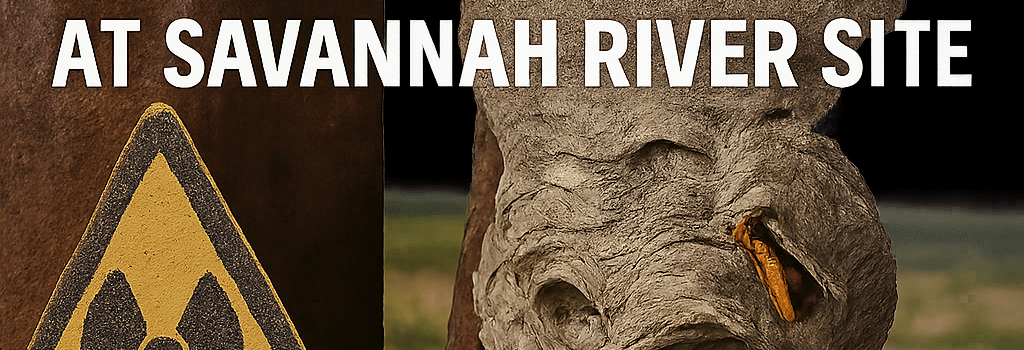Radioactive Wasp Nests Raise Contamination Concerns at Savannah River Site

Overview of the Incident
In July 2025, officials at the Savannah River Site (SRS) near Aiken, South Carolina, identified four wasp nests with measurable radioactive contamination. The discoveries, documented in a July 22 report by the US Department of Energy (DOE), raise fresh questions about legacy contamination, environmental monitoring protocols, and the vectors by which radioisotopes disperse in the ecosystem.
Timeline of Discoveries
- July 3, 2025: First radioactive nest detected on a support post adjacent to a nuclear waste storage tank
- Mid-July 2025: Three additional nests found within a 500-yard radius of legacy processing areas
- July 22, 2025: DOE publishes preliminary contamination levels in an internal report
Measured Contamination Levels
The initial nest registered 100,000 dpm/100 cm2 beta/gamma on contact, exceeding federal posting thresholds by a factor of ten. Instruments used included Geiger-Müller tubes calibrated for beta/gamma spectroscopy, and NaI(Tl) scintillation counters for field surveys. Despite these readings, DOE maintains that the source is “onsite legacy radioactive contamination” rather than an active leak.
“The nests do not pose a health risk to SRS workers, the community, or the environment,” said Edwin Deshong, manager of the DOE’s Savannah River Operations Office.
Site Background and Legacy Contamination
Constructed in the 1950s to produce plutonium and tritium for nuclear weapons, SRS spans 310 square miles. Over decades, the site generated approximately 165 million gallons of high-level radioactive liquid waste. Through evaporative processing, this volume was reduced to 34 million gallons stored across 51 underground tanks, eight of which are operationally closed and 43 are in various stages of remediation.
DOE’s long-term cleanup, initiated in 1996, employs vitrification and grout technologies to immobilize radionuclides such as Cs-137, Sr-90, and americium. The Site’s Integrated Waste Treatment Unit (IWTU), commissioned in 2019, demonstrates the application of high-temperature fluidized bed reactors to convert liquid waste into a ceramic matrix.
Expert Analyses and Unanswered Questions
External experts highlight missing data in DOE’s report, including:
- Absolute activity concentrations for each isotope detected
- Identification of specific radioisotopes (alpha, beta, gamma emitters)
- Species of wasp responsible and nest composition (mud vs. chewed wood pulp)
Timothy Mousseau, a radioecology specialist at the University of South Carolina, noted that “soil and lake sediments contain pockets of legacy radionuclides that could be mobilized by foraging insects.” He added that unmonitored hot spots might be surfacing unexpectedly.
Deeper Analysis
Potential Ecological Impact
Wasps typically forage within a few hundred yards of their nest, but if contaminated, they can transfer radionuclides to:
- Soil and leaf litter, through nest construction materials
- Predatory insects and birds, via trophic transfer
- Surface runoff, during rainfall events that wash particles into nearby waterways
Historic reports at SRS include radioactive bird droppings found on distant rooftops, demonstrating how fauna can disperse contamination beyond monitored zones.
Advanced Monitoring and Detection Technologies
In response to these discoveries, DOE is evaluating new sensor deployments:
- High-purity germanium (HPGe) detectors for on-site gamma spectroscopy
- Unmanned aerial vehicles (UAVs) equipped with lightweight scintillation arrays
- Distributed fiber-optic radiation sensors providing real-time dose rate mapping
These systems can detect isotopes down to 5 Bq m-2 and identify Cs-137 vs. Co-60 through energy window discrimination.
Implications for Radioecology Research and Policy
The wasp-nest findings underscore the need for:
- Routine biodiversity surveys integrated with radiological screening
- Cross-disciplinary teams combining entomologists, health physicists, and ecologists
- Refined regulatory thresholds that account for bioavailable contamination vectors
Emerging policy discussions at the International Atomic Energy Agency now emphasize ecosystem resilience and the role of small fauna in radionuclide cycling.
Next Steps and Ongoing Investigations
DOE has collected and bagged all four nests as low-level radioactive waste. Continuous surveys are being expanded to include 100 additional monitoring points within the southwestern buffer zone. Entomologists will identify wasp species, while radiochemists will perform gamma spectrometry and alpha autoradiography on nest materials.
The ultimate goal is to refine SRS’s environmental surveillance strategy ahead of the projected site closure in 2065, ensuring that residual contamination remains below actionable limits.